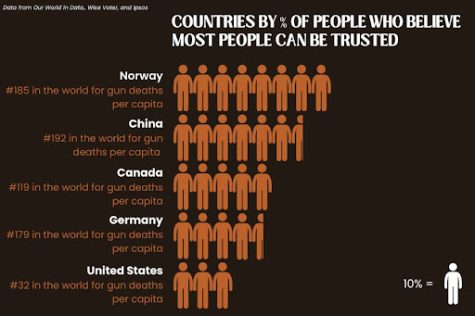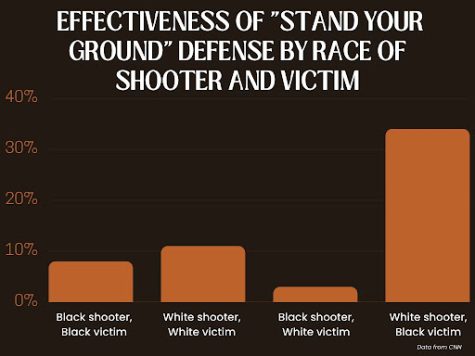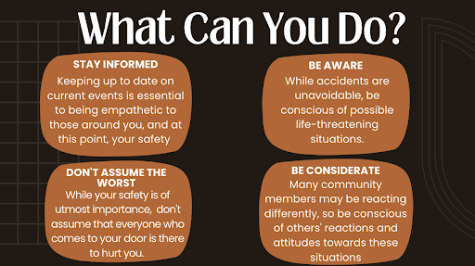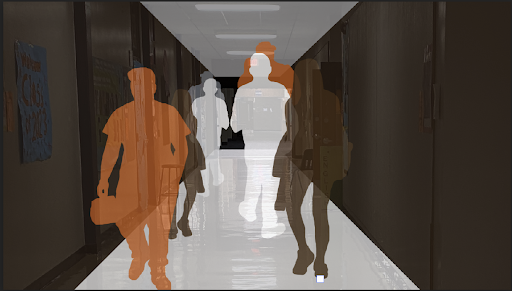In America we (dis)trust: the effects of guns on America’s youth
May 31, 2023
Ringing the wrong doorbell. Pulling into the wrong driveway. Opening the wrong car door. Dropping a basketball in the wrong backyard. Once seen as innocent mishaps, these actions may warrant a death sentence for innocent teenagers.
Missouri’s Ralph Yarl, New York’s Kaylin Gillis, Texas’ Payton Washington and North Carolina’s Kinsley Hilderbrand have all found themselves victim to chance, the violence of their neighbors and the epidemic of distrust in the U.S. today. All four young adults and children were victims of shootings in quick succession in these last few weeks, highlighting systemic problems in American gun culture. Dubious laws have recently propagated these problems.
“Stand your ground” laws have been frequently covered in the news surrounding these shootings; however, many people are unaware of the laws’ effects, only taking them at face value, which is that the laws are meant to protect individuals who choose to fight back against anyone whom they may interpret as a threat. The castle doctrine — the common legal principle that U.S. states base their specific “stand your ground” laws on — claims that individuals have the right to use “reasonable” force, including “deadly” force, to protect themselves against an intruder in their home.
This “stand your ground” principle has been codified and expanded by state legislatures. In Missouri, the law specifically states that there is no duty to retreat from an attacker in any place in which one is lawfully present. This means that if someone feels endangered in their home, car or another place they were lawfully present such as a shopping mall or parking lot, they are not required to attempt to escape from an offender before resorting to brutality in order for the violence to count as self-defense.
The difference between “stand your ground” laws and other self-defense laws is that “stand your ground” laws remove the “duty to retreat” principle from the law, which is the principle that requires the victim to try to flee danger until there is nowhere else to go, after which the victim is allowed to harm the attacker.
While self-defense laws also do this, “stand your ground” principles contain vague terms that leave much up for interpretation. The difference between the vague language of other self-defense laws and the vague language of “stand your ground” laws is that the “stand your ground” laws give room for defendants to justify unnecessary violence as it allows citizens to use “reasonable force” if they feel “reasonably threatened.” This leaves room for interpretation by the jury, the narrative that the lawyers present to the court and the demographic of the people involved, meaning that the implicit systemic issues in the judicial system lead to unjust rulings.
These laws first came into controversy after the 2012 death of Trayvon Martin, a Black teenager who was shot while walking home from a convenience store in Florida. The shooter, George Zimmerman, was sitting in his car when he saw Martin walking down the street. Zimmerman called the police and reported “a suspicious person,” to which the police advised him to stay in the car until they got there. Zimmerman did not do so, leaving his car and shooting Martin in the street. A Florida jury acquitted Zimmerman of all charges after they received instructions about the state’s “stand your ground” law approved in 2005.
Recently, there have been four more youth shootings accidentally in the wrong place at the wrong time. This elicits national attention to the frightening willingness of these attackers to shoot someone and how the U.S. legal system protects these trigger-happy individuals. Distrust in the U.S. is at an all-time high, so much so that it is now dangerous to make even an innocent mistake like the ones made by the victims of these shootings.
American Distrust
“Stand your ground” laws have become relevant again after a string of independent shootings, all resulting from the victims’ simple mistakes and the actions of paranoid gun owners. This increase in shootings is most likely correlated with the inflated aggression levels following the COVID-19 pandemic and quarantine. Unsurprisingly, it’s common on social media sites such as Twitter, Facebook or Reddit for users to create dangerous echo chambers that lead to stark political polarization and environments that encourage individuals to hold extremist views. And as an increasing number of Americans hold extremist views, it is followed by an increase in shootings.
“I’m amazed at how quickly people react and, now, use a gun. I mean, that’s new. Everybody’s so fast to react. I truly think social media has brought that about because we all want information immediately. We see something, and we react right away, but the fact [that] guns [are] brought into it, that’s the more horrific end of it,” Crime and Law teacher Nancy Sachtleben said.
In a way, people have become all too happy to take disputes that should be left to the police into their own hands and shoot a gun. Some states have even nicknamed “stand your ground” laws “make my day” laws, implying that the excuse to shoot someone is almost a reward.
The percentage of American households that own one or more firearms has spiked in recent years, reaching a high of 45% in 2022. And while 48% of gun owners say they own a gun for self-protection purposes, less than 1% of crime victims reported using it in self-defense. The U.S. also owns far more guns than any other first-world country. In second place is Canada, which owns only one-third as many guns as the U.S. French teacher Blair Hopkins — who has lived in three countries, including the U.S. — has seen how citizens view guns and violence in various nations.
“[Americans’ protection of guns] doesn’t have anything to do with the Constitution. Americans are very, very attached to individual freedom. [Individual freedom] is one of the things I really like about living in the U.S., but people have a hard time seeing where [their individual rights] intrude on someone else’s right to do something,” Hopkins said.
This high concentration of gun ownership correlates with a concerning percentage of Americans who feel less trusting of others. In the 1970s, about half of Americans said they believed most people could be trusted. Now, that number is less than one-third. Additionally, the U.S. is the only established democracy with a decreasing trust level in both government and other people.

Ironically, these shootings are only an additional source of contention for the increasingly polarized two-party system. Democrats and Republicans are at odds about what to do in response to gun violence, with Democrats advocating for gun control and Republicans standing equally strongly against it. Either way, politicians are using important topics as leverage for their side, leading to people on all sides’ unmet needs.
“There’s more concern about crime and violence in the U.S.,” Hopkins said. “The two-party political division in the United States is much stronger and causes more tension than I have noticed in any other place I’ve lived.”
There is an unwarranted fear of crime in the U.S., with Americans’ fear of crime rising for the last two decades. This is often blamed on the media, with some claiming that the focus on crime in political news and the overexposure of criminals has skewed Americans’ perception of crime.
The fact that America has such a high amount of guns and a low level of trust is not a coincidence. The fear of crime and distrust in fellow citizens leads to an increase in the acquisition of guns and an increase in fear of others, continuing the mutual causality between distrust and gun violence. It becomes an incessant cycle: distrust leads to gun acquisition, which leads to gun violence which, in turn, leads to further gun violence and crimes.
The fault with “stand your ground” laws
The “stand your ground” laws also unfairly target minorities and adolescents. Preconceived biases — especially of Black and Hispanic people — cause disproportionate reactions to the perception of being threatened. A study in Florida showed that Black adolescents aged 15-19 were twice as likely to be shot out of defense as their white counterparts.
This injustice is saddening but not surprising. Studies show that Black teenage boys are often viewed as less innocent and “older” when compared to white boys in similar situations. These prejudices make Black boys more susceptible to greater violence in response to minor issues than white boys. This gap was evident in the Trayvon Martin case, where Martin’s identity was seen as so threatening that it warranted death. This disparity is not just a problem of violence toward African Americans but an issue of how the justice system treats murderers of innocent Black people. Given the preconceived bias that certain minorities are more dangerous than others, a law based on the sense of danger that the victim feels they are in would also follow these same prejudiced biases.
“A Black child could have lost his life over nothing; [Yarl] posed no threat. He made no threats: he knocked on the door,” Black Student Union vice president and junior Anijah Wilson said.
“But at the same time, I don’t expect him to be protected by [the] laws of a nation that doesn’t consider us human. How could you expect people’s outlook deciding on guilty or innocent toward Black people, who have been historically painted as evil?”

When considering historical context and the prejudiced fear of Black individuals — especially Black men — it is even less surprising that courts in “stand your ground” states are five times more likely to find a white person’s killing of a Black person to be justified than when a Black person kills a white person. By innately creating unfair standards in the courtroom due to implicit prejudice and bias, “stand your ground” laws favor one group over another, which furthers systemic racism in the justice system and the unfair disadvantage Black defendants have in the courts.
“[‘Stand your ground’ laws don’t] necessarily state what has to be done towards you in order for you to ‘stand your ground.’ Of course, it has to be something violent, or you have to feel threatened to ‘stand your ground,’ but what does strike me [is] what has historically been considered a threat,” Wilson said.
Besides the clear racial disadvantage that “stand your ground” laws give Black defendants in courts, it also encourages citizens to shoot first and ask questions later. This leads to increased homicides — both justified and unjustified — as many citizens believe it is their right and in their best interest to kill anyone that threatens them without considering possible alternatives.
In the first decade after Florida enacted their “stand your ground” law, homicides increased by 22% and “justifiable” homicides increased by 75%, despite the fact that 57% of these homicides showed clear evidence of the fact that the person who claimed “self-defense” could’ve safely retreated to escape the potential threat.
But across the nation, states with “stand your ground” laws witnessed a 53% average increase in the justifiable homicide rate after the law’s passage. But states without “stand your ground” laws experienced an average decline of 5% in justifiable homicides during the same period. This data all reflect one horrifying fact: “stand your ground” laws simply lead to unnecessary murder that the criminal seems to be getting away with.
Clearly, “stand your ground” laws are not acceptable defenses when they not only excuse unnecessary murder but also aid the systemic racism in judicial courts. Any law allowing prejudice and violence can not be accepted in the American justice system.
Effects on the younger generation
The problem of gun violence seems to be disproportionately affecting youth as well, with gun violence now being the top cause of death for teens and children. Gun violence surpasses prior top causes like car accidents, cancer and poisoning. This concerning trend has been reflected in these recent shootings, with the oldest victim being 20 and the youngest being just six.
The U.S. has a gun homicide rate among young people that is 49 times higher than other developed nations. Additionally, three to four Americans under the age of 18 are murdered with a firearm every day, and about one in five students in the U.S. have seen violence first-hand.
Why young people are experiencing gun violence at such high rates can be attributed to children being more vulnerable and having less life experience, which may lead to simple mistakes like the one’s made by Ralph Yarl or Payton Washington. This, combined with running into the wrong person by accident, leads to horrific incidents of gun violence.
Despite being so highly affected by gun violence, young people are becoming increasingly desensitized to gun violence. As mass shootings become an epidemic in the United States, many teenagers aren’t even aware of all the horrific tragedies occurring in their nation, or worse, don’t care.
“[When shootings are brought up, students say] ‘what shootings?’ We’ve talked about a few [of the shootings] here and there in class, and it comes back to being aware of your surroundings; that’s what I’ve said to my students,” Sachtleben said. “Unfortunately, it’s getting to be like this, but [there is] safety in numbers, and students need to be aware of their surroundings.”
But students are hardly to blame for their ignorance of the subject. When new shootings and victims grace headlines daily, it can be difficult to take an interest in every single one. Even though it’s necessary for young people to care about each and every horrific killing that occurs, this can result in burnout.
Much of the reason burnout is occurring so often in students is that there is little students can do about this because they can’t vote since it is clear that gun control — or lack thereof — is the most significant factor in the rising violence.
Even though 63% of young Americans favor stricter gun control, little legislation has been passed since the 1994 assault rifle ban passed under the Clinton administration, which saw positive short-term effects on not only the number of mass shootings but also the number of fatalities in mass shootings until its expiration in 2004.
Legislative control on guns is necessary to do anything to curb gun violence, but specifically needed is legislature responding to the problem of illegally possessed guns.
At least 40% of guns used for crimes are possessed illegally. Tightening accessibility to guns can lessen the amount of gun-related injuries and deaths. In the same light, limiting “ghost guns,” or unserialized and untraceable guns purchased online, can also lessen these related injuries and deaths. Ghost guns are typically purchased one component at a time and then, once assembled, function as a traditional gun. There are currently no federal regulatory laws on ghost guns.
Another major factor is that legally purchased guns may be passed onto people who would not regularly pass a gun background check. This completely defeats the purpose of gun background checks, which is to ensure that anyone deemed unfit to own a gun cannot buy one. This entails checking criminal history, mental health records or drug use. When guns are given as gifts or sold at garage sales, it is impossible to stop guns from getting into the hands of potentially dangerous people. This has shown to be a major issue in gun violence, as 54% of guns used in crime were originally obtained legally before being used illegally.
Additionally, gun control restricting the legal purchase of firearms is especially necessary, as a study done on the 1994 assault rifle ban found that an assault weapons ban would have prevented 314 out of 448 or 70% of the mass shooting deaths during the years when the ban was not in effect. In addition, the same study showed the number of gun massacres during the ban period fell by 37% and that the number of people dying because of mass shootings fell by 43%.
This is true for large-capacity magazines (LCMs) as well. A study of state gun laws concluded that bans on LCMs are associated with 38% fewer fatalities and 77% fewer nonfatal injuries in mass shootings.
The necessity of bans on certain types of guns is clear, especially when you compare the U.S. to other countries with high gun ownership, like Switzerland. Despite also having a high gun ownership rate — though not as high as the United States — there has not been a mass shooting since 2001. This is because of their gun laws; citizens of Switzerland are not permitted to own automatic weapons, silencers or heavy machine weapons, which according to Business Insider, is correlated to extremely low levels of mass shootings.
“[These shootings] make me feel upset because they feel like something that could [have] been prevented. It feels like something that if young people were taught more, and if we had more regulations in place, it could be something that didn’t have to happen,” junior Emily McCarthy said.

Despite over 13,900 people being killed by gun violence in 2023, Democrats and Republicans are still harshly divided over gun control, and the debate is becoming increasingly polarized. The excuse that gun control is a political issue is dangerous and harmful to our society. By marking gun control as a ‘left’ versus ‘right’ battle, we are refusing to deal with the real issues and consequences of a lack of gun control.
“It seems pretty clear to me that if mass shootings are happening all the time, that’s bad and that shouldn’t be political,” Hopkins said.
Despite students’ inability to modify gun laws or legislation, we must do what we can and protect ourselves through self-awareness.
“The person who shot Ralph was in his late 80s, so I feel the fact that it’s [disproportionately affecting young people] is sad and disappointing. I also [feel] like I need to watch what I’m doing even if it’s common sense [not to shoot]. You make mistakes as a teenager, [but] I need to be more aware when I [make mistakes] because it can be anybody who is having a bad day,” Wilson said.



Douglas Holcomb • Jun 2, 2023 at 8:56 am
Insightful, informative and well written. I would hope those in our government would read this, take it to heart and act upon it.
Bradd Holcomb • Jun 2, 2023 at 8:06 am
Well researched and well written!
Jack • Jun 1, 2023 at 10:49 am
Very interesting!